German sauerkraut with pork: Fermented white cabbage simmered with apples, pork steaks and sausages in white wine and spices.
Recipe Intro
Sauerkraut is a favourite across Central and Eastern Europe, with each country putting its own spin on the dish. It perfectly pairs with pork, whether in one-pot stews, alongside fried sausages, or with roasted meat.
Sauerkraut with apples is especially popular in southern Germany (Sauerkraut mit Schweinefleisch), and it’s also commonly made this way (with slight variations) in much of western Austria, particularly around Salzburg.

In Germany, sauerkraut is a popular street food, commonly served with chunks of roasted pork, often drizzled with mustard or curry sauce. This hearty combination is a staple at food stalls and markets, offering a perfect balance of sour and savoury flavours.
Did you know? Written records show that sauerkraut first appeared in China about 2,000 years ago. It arrived in Europe around 800-900 years ago during Genghis Khan’s invasions of China. As the Tatars moved into Eastern Europe, they brought traditions from the Far East, including fermenting cabbage and other vegetables. This custom soon took root here, especially in the countries that now make up Central and Eastern Europe. Today, sauerkraut is extremely popular in Eastern European countries, Germany, and even some parts of France.
Essential ingredients for German sauerkraut with pork
- sauerkraut – Fermented white cabbage, typically with a tangy, slightly sour flavour. For a milder version of this dish, you can use plain white cabbage, finely shredded or thinly sliced.
- pork – Pork shoulder steaks are an excellent choice due to their tenderness and flavour, but you can also use other cuts of pork such as pork belly or pork chops. Add your favourite pork sausages. Feel free to mix and match different sausage varieties for a unique flavour.
- white wine – Use a dry or sweet white wine of your choice. Avoid using red wine, as its boldness can overpower the dish.
- apples – Use a sweet variety. The sweetness from the apple helps balance the tanginess of the sauerkraut and they go hand in hand with everything pork!
- spices: caraway seeds, cloves, juniper berries, and a bay leaf – Caraway seeds, juniper berries, and cloves are key to giving this dish its distinctive German flavour. While juniper berries might be harder to find, don’t skip the caraway seeds, as they’re essential. You can use a mix of whole and ground caraway seeds if you prefer.
While you are here, please check these tasty international recipes featuring pork 🐷
Traditional Chinese Sweet Pork Belly
Authentic Polish Golabki – cabbage with minced meat
Easy pork and leek hearty stew
How to make Bavarian-style sauerkraut with pork?
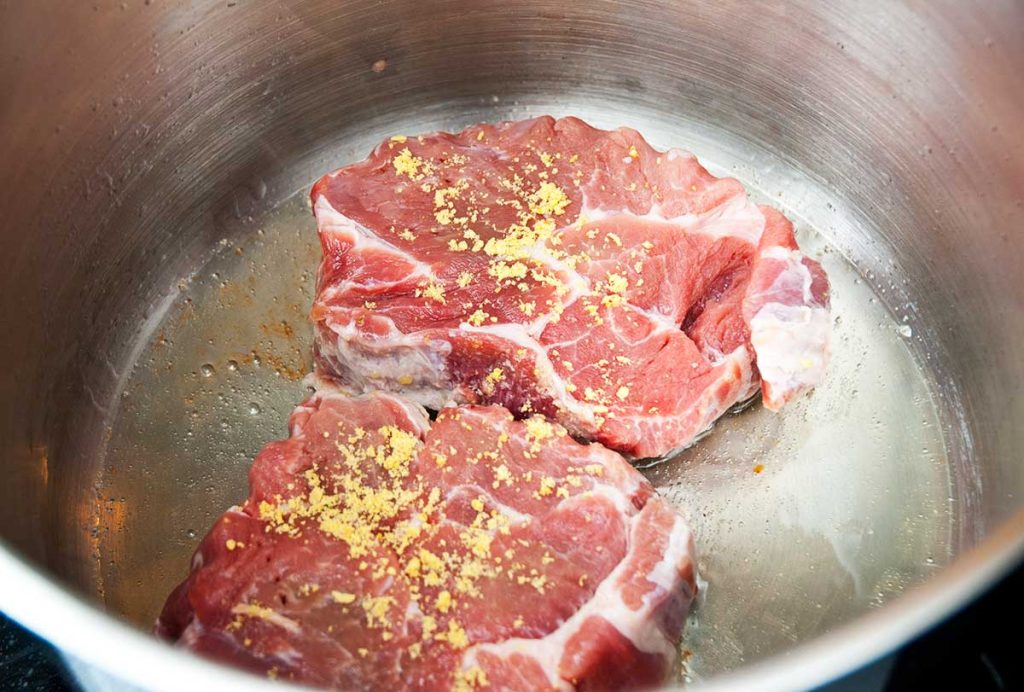
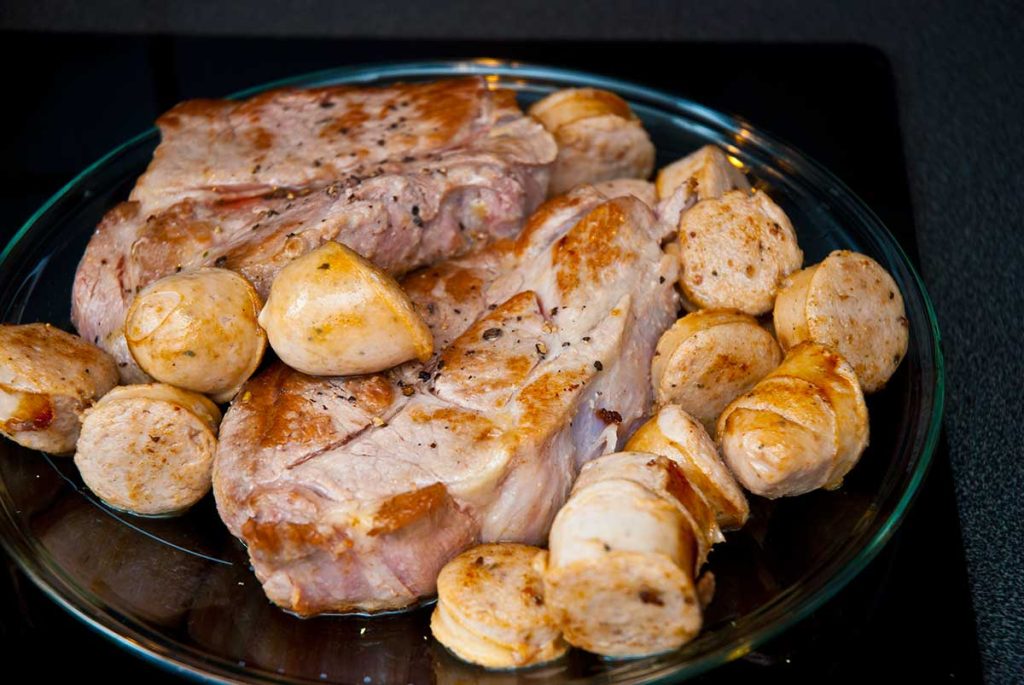
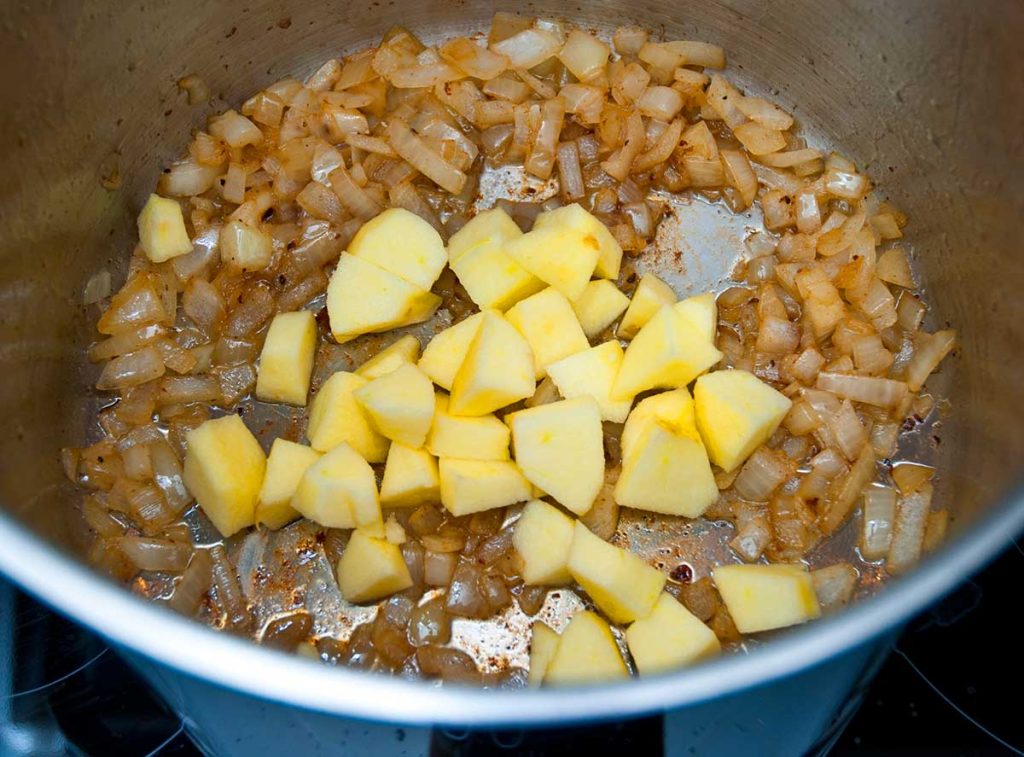
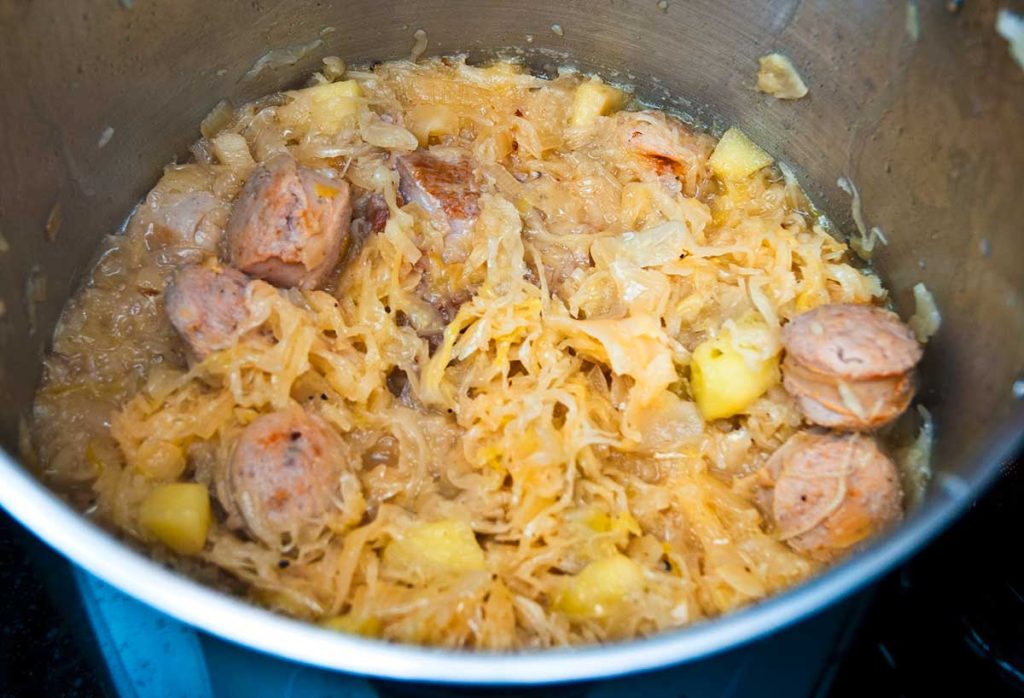
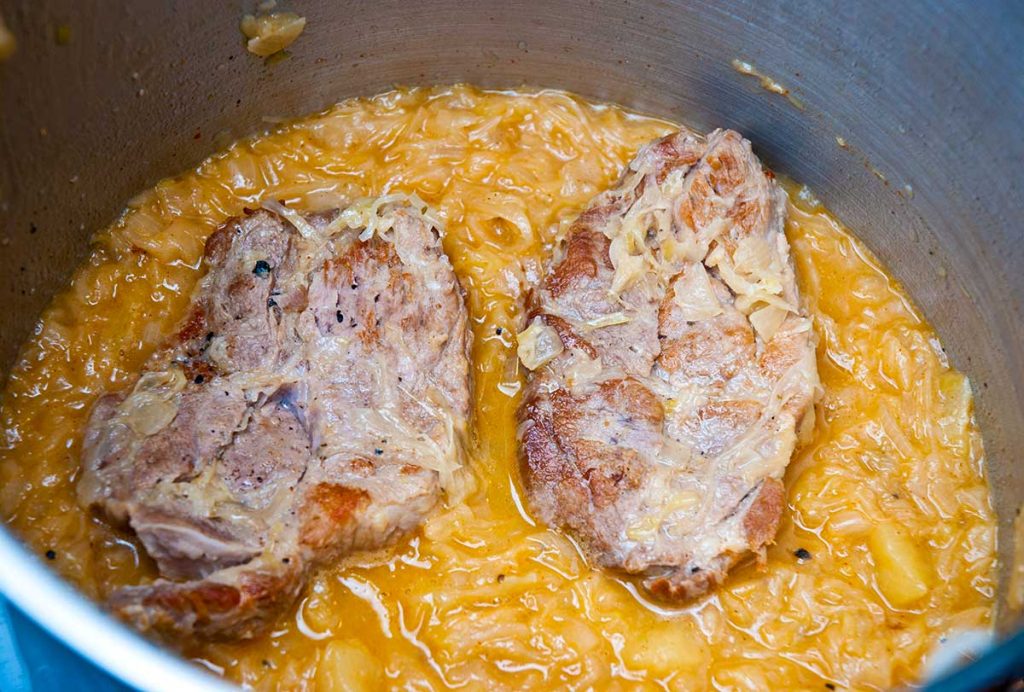
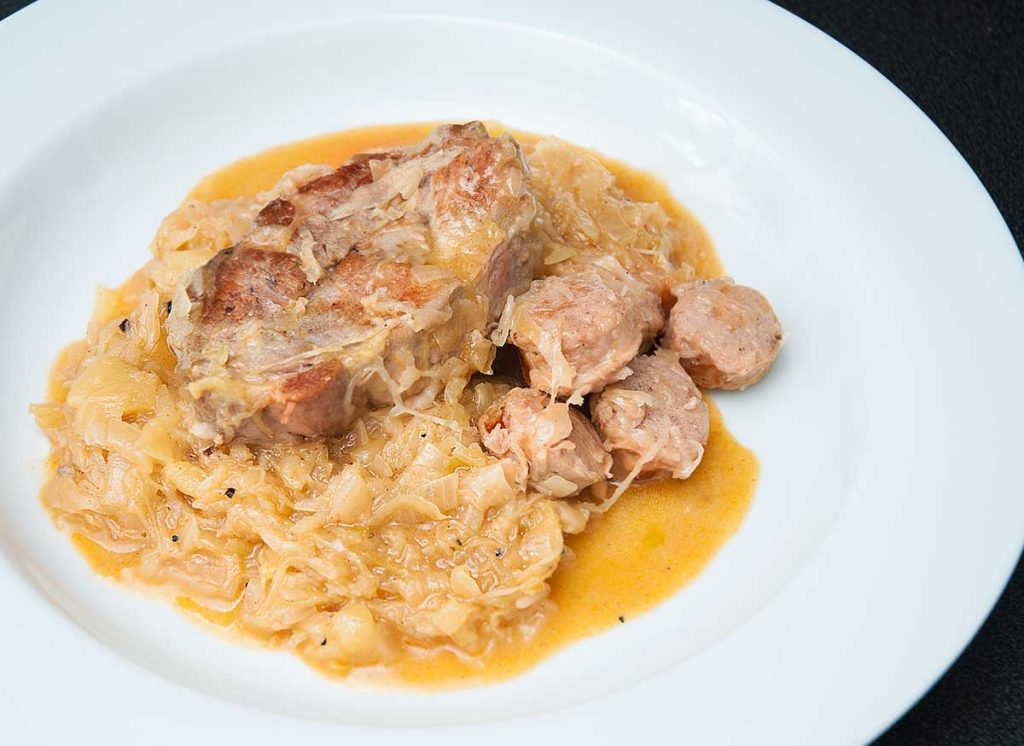
1. Prepare pork
You don’t have to stick to just two pork steaks for this dish, you can have 3 or 4, depending on how many you’re serving. You can skip the sausages entirely, add different types of sausages, or even use a variety of pork cuts for added flavour.
- No need to tenderize the steaks. Simply season them with salt and pepper, and slice the sausages into smaller pieces.
- In a large pan, melt some butter and gently brown the meat for 2–3 minutes on each side. Once seared, remove the meat and place it on a plate, covering it to keep warm.
- In the same pan, fry the sausages for 2–3 minutes until golden, then set them aside with the meat.
2. Prepare sauce base for German sauerkraut with pork
Sauerkraut is a wonderfully versatile ingredient, but it’s important to check its saltiness before cooking. Some brands offer ready-to-use sauerkraut that requires no rinsing, while others can be quite salty and may benefit from a quick rinse or two. Simply taste a small amount to judge whether it needs rinsing. It’s always easier to add a pinch of salt later in the cooking process than to risk an overly salty dish right from the start.
- In a large pot, heat the lard with a little sunflower oil, then add the chopped onions. Sauté them gently over low to medium heat for about 10 minutes until perfectly caramelised.
- Add the diced apples and cook for another 2 minutes.
- Once the apples soften, add the sauerkraut and stir well to combine. Let it fry gently for 3–5 minutes, stirring frequently so the sauerkraut softens and the flavours blend. Then, pour in the wine, allowing it to simmer briefly (for 3 minutes) and absorb into the mixture.
- Dissolve a vegetable or chicken stock cube in 500–600ml of warm water, stirring until fully combined. Once dissolved, pour the broth into the pot.
- Next, add the remaining ingredients: caraway seeds, cloves, juniper berries, and a bay leaf. I also like to add a teaspoon or two of sweet paprika, which isn’t traditional, but it gives a touch of colour. Stir everything gently to combine.
- Place the seared pork steaks and sausages into the pot. Stir gently to coat them in the sauce, allowing the meat to settle into the sauerkraut mixture. Feel free to add extra water to ensure it cooks evenly.
- Simmer for around 40 minutes, until the sauerkraut is tender, the meat is cooked through, and the sauce has thickened.
How to serve German sauerkraut with pork?
This dish is traditionally served with boiled or mashed potatoes, and occasionally with crusty bread to soak up the delicious sauce. Mustard is often provided on the side. And don’t forget a glass of cold lager or wheat beer. Guten Appetit!
🍽️ Try serving this German sauerkraut and pork with one of these tasty potato side dishes :
Spanish potato omelette 🥔🍳
Texas potato salad. 🥔🥗
Recipe Card
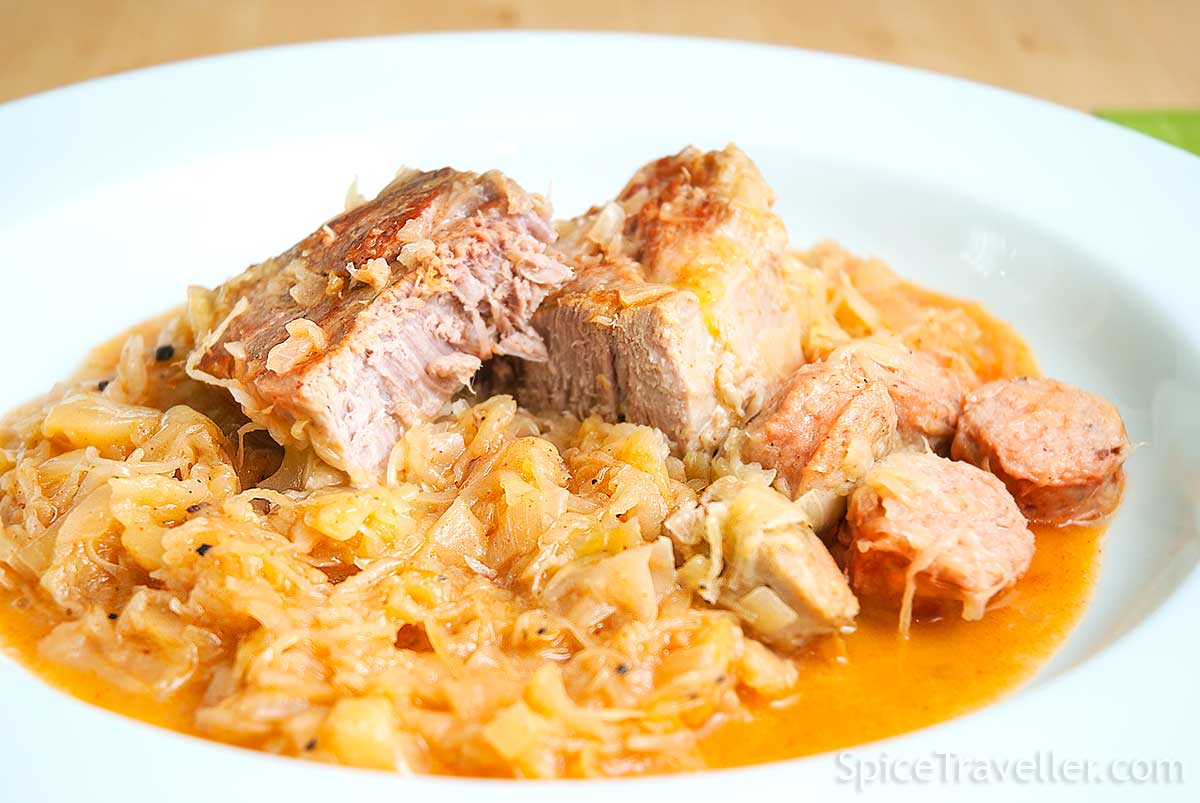
Bavarian style sauerkraut with pork shoulder steaks and sausages
Ingredients
- 2 pieces pork shoulder steaks - chops or cutlets
- 1-2 pork sausages
- 400 g sauerkraut
- 1 large onion
- 1 tbsp brown sugar
- 1 large apple - sweet variety
- 200 ml white wine - dry or sweet
- 1 tsp caraway seeds
- 2 cloves
- 1 tbsp juniper berries
- 2-3 bay leaf
- 600 ml chicken or vegetable broth - or stock powder/cube+water
- 2-3 tbsp sunflower oil
- 25 g butter
- 1 tbsp lard
- salt, pepper - to taste
Instructions
- Prepare the Pork You can use 2, 3, or 4 pork steaks depending on the number of servings. No need to tenderise the steaks, simply season them with salt and pepper. Slice the sausages into smaller pieces.In a large pan, melt butter and sear the pork steaks for 2–3 minutes on each side. Remove the meat and keep it warm. In the same pan, fry the sausages for 2–3 minutes until golden, then set them aside.
- Prepare the Sauerkraut BaseCheck the saltiness of the sauerkraut before cooking. Some brands need no rinsing, while others may require a quick rinse to reduce saltiness. In a large pot, heat lard and a little sunflower oil, then sauté chopped onions over low-medium heat for about 10 minutes until caramelised.Add diced apples and cook for 2 minutes. Stir in the sauerkraut and cook for 3–5 minutes, stirring frequently.
- Pour in the wine and let it simmer for 3 minutes.Use ready-made broth or dissolve a vegetable or chicken stock cube in 500–600ml of warm water, then pour it into the pot. Add caraway seeds, cloves, juniper berries, bay leaf, and sweet paprika (optional). Stir to combine.
- Add the seared pork steaks and sausages into the pot, mixing gently to coat them in the sauce and cabbage. Add extra water if needed. Simmer for 40 minutes until the sauerkraut is tender, the meat is cooked, and the sauce has thickened.
